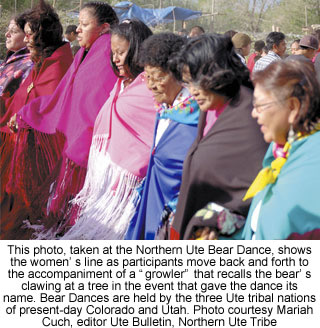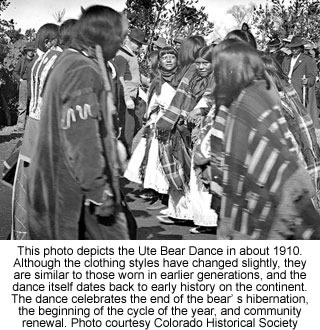 |
Canku Ota
|
 |
|
(Many Paths)
|
||
|
An Online Newsletter
Celebrating Native America
|
||
|
August 1, 2009 - Volume
7 Number 8
|
||
|
|
||
|
Circle Of The Year's
Seasons Begins In The Intermountain West
|
||
|
by Carol Berry, Indian
Country Today correspondent
|
||
 TOWAOC,
Colo. – It may be spring in the Rocky Mountains but for Ute
tribal members in Colorado and Utah it's "Indian New Year," as one
celebrant said. TOWAOC,
Colo. – It may be spring in the Rocky Mountains but for Ute
tribal members in Colorado and Utah it's "Indian New Year," as one
celebrant said. Towaoc, home of the Ute Mountain Ute Tribe, is the site of a huge family and community renewal, the Bear Dance, with some 5,000 attendees expected on the last of four days of the event that opens the circle of the seasons each spring. "Every year, after the long hard winter, ‘you dance to go on', the bear told us. Ever since, we do that," said Antonio Kanip, Northern Ute, Fort Duchesne, Utah, at 34 one of the youngest Bear Dance chiefs. "The Bear Dance has been around long before the Spaniards, long before the first Pilgrims stepped foot on Plymouth Rock, decades and decades back." The Bear Dance marks the end of hibernation for the bear and sharing of the bear's spring celebratory song and dance with the Ute people, according to an account that varies from band to band. Originally observed earlier, it generally now takes place in May. "When the Bear Dance first started, the Ute people had a spring solstice ceremony for the new year," Terry Knight, Ute Mountain Ute Bear Dance chief, said. "About that time you would hear the first thunder and then you knew that spring was coming." The bear is the guardian spirit of the Ute people, who are mountain people, he said.
Bear Dances and accompanying events such as pow wows and hand games are held at Towaoc, Fort Duchesne, Ignacio, Colo., home of the Southern Ute Tribe, where 2,000 people attend the annual celebration, and at other locations. In the Bear Dance, a ladies'-choice social dance, men and shawl-wearing women form separate lines and move in a back-and-forth pattern, later dancing as couples and, on the last day, in an endurance round that continues until a dancer drops or the drum tires out. A "cat man" keeps order using a long willow stick, if necessary, to line up the dancers. "It's like the circle," Kanip said of the Bear Dance, explaining it is part of the spring celebration beginning the cycle of the year. "It opens up the new year – all activities, whatever takes place – the Sun Dance, a good hunting season, then later to make it through the winter." He said he has seen the dance help people who are sick, and older people are happy at the continuity of life represented by the young dancers. Kanip began the duties of Bear Dance chief at about age 20 at the insistence of his elders after he helped his grandfathers with the celebration and despite his own misgivings. "I was just a young guy and I wasn't supposed to be standing up and doing that as a leader of some ceremony." Now more comfortable with it, "I do have familiarity with how people are going to benefit from it." Matthew Box, Southern Ute tribal chairman and Bear Dance chief, described the ceremony in a presentation prepared with the Colorado Historical Society, noting there is a lesson in the Bear Dance of how to survive, but it is also a "way of rejuvenating the spirit which is different than just surviving." Box explained that during part of the year Ute bands might be separated while hunting, gathering herbs, or following other pursuits, but they would come together at Bear Dance time and "be unified again as a people." The large social gathering at the Bear Dance requires a lot of preparation, said Andrea Taylor, Southern Ute director of information. A hardwood stick is grooved so it makes the rasping sound of the "growler" and 12 extra grooved ax handles were kept this year for visitors who wanted to participate but didn't bring their own instruments, she said. Taylor also described plans for the last-day feast, when some 2,000 participants and attendees will eat beef stew, frybread, watermelon and desserts. She said cooking fires and a cooking arbor had to be set up; the large dancers' arbor and a corral prepared; seven separate departments of the Southern Ute Tribe coordinated; and 150 staff and volunteers, some of them from Fort Lewis College in Durango, Colo., supervised. Similar preparations are underway for the Northern Ute celebration and at Towaoc, where artists create elaborate paintings of bears for the Ute Mountain Ute dance. Preceding the Bear Dances was the Chipeta Walk to Remember May 2 at the Ute Indian Museum, Montrose, Colo., where attendees walked in the rain to honor Chipeta, well-known wife of Ute Chief Ouray. She was a member of the Uncompahgre Band, removed from Colorado to Utah in 1881. |
|
|
||
|
|
||
| Canku Ota is a free Newsletter celebrating Native America, its traditions and accomplishments . We do not provide subscriber or visitor names to anyone. Some articles presented in Canku Ota may contain copyright material. We have received appropriate permissions for republishing any articles. Material appearing here is distributed without profit or monetary gain to those who have expressed an interest. This is in accordance with Title 17 U.S.C. Section 107. | ||
|
Canku Ota is a copyright ©
2000, 2001, 2002, 2003, 2004, 2005, 2006, 2007, 2008, 2009 of Vicki
Barry and Paul Barry.
|
||
 |
 |
|
|
The "Canku
Ota - A Newsletter Celebrating Native America" web site and
its design is the
|
||
|
Copyright ©
1999, 2000, 2001, 2002, 2003, 2004, 2005,
2006, 2007, 2008, 2009 of Paul
C. Barry.
|
||
|
All Rights Reserved.
|
||
 A
condensed history is that a Ute man hunting in spring in the mountains
saw a bear from afar who was singing and dancing toward and then
away from a tree. The bear taught the song and dance to the hunter
to take back to his people for their benefit. Over time, Ute families
and bands developed variations and songs about the event, and in
the dance use instruments called "bear growlers" to simulate the
bear's clawing at the tree.
A
condensed history is that a Ute man hunting in spring in the mountains
saw a bear from afar who was singing and dancing toward and then
away from a tree. The bear taught the song and dance to the hunter
to take back to his people for their benefit. Over time, Ute families
and bands developed variations and songs about the event, and in
the dance use instruments called "bear growlers" to simulate the
bear's clawing at the tree.